Page 177 of 474
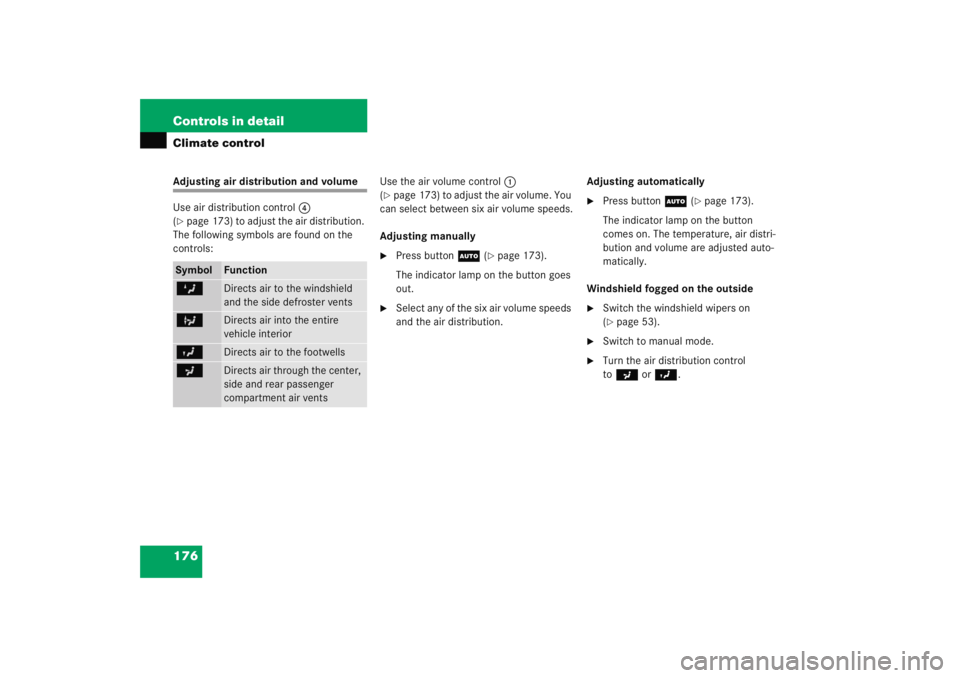
176 Controls in detailClimate controlAdjusting air distribution and volume
Use air distribution control4
(�page 173) to adjust the air distribution.
The following symbols are found on the
controls: Use the air volume control
1
(
�page 173) to adjust the air volume. You
can select between six air volume speeds.
Adjusting manually
�
Press button U (
�page 173).
The indicator lamp on the button goes
out.
�
Select any of the six air volume speeds
and the air distribution. Adjusting automatically
�
Press button
U (
�page 173).
The indicator lamp on the button
comes on. The temperature, air distri-
bution and volume are adjusted auto-
matically.
Windshield fogged on the outside
�
Switch the windshield wipers on
(�page 53).
�
Switch to manual mode.
�
Turn the air distribution control
to a orY .
Symbol
Function
Z
Directs air to the windshield
and the side defroster vents
b
Directs air into the entire
vehicle interior
Y
Directs air to the footwells
a
Directs air through the center,
side and rear passenger
compartment air vents
Page 178 of 474
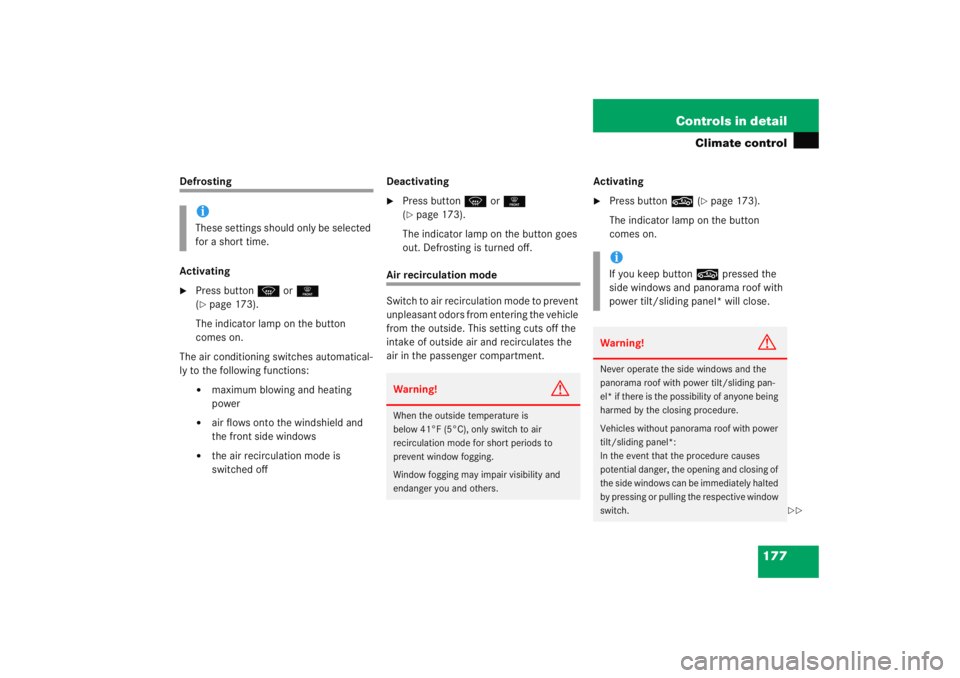
177
Controls in detail
Climate control
Defrosting
Activating�
Press button
P or0
(�page 173).
The indicator lamp on the button
comes on.
The air conditioning switches automatical-
ly to the following functions:
�
maximum blowing and heating
power
�
air flows onto the windshield and
the front side windows
�
the air recirculation mode is
switched off Deactivating
�
Press button
P or0
(�page 173).
The indicator lamp on the button goes
out. Defrosting is turned off.
Air recirculation mode
Switch to air recirculation mode to prevent
unpleasant odors from entering the vehicle
from the outside. This setting cuts off the
intake of outside air and recirculates the
air in the passenger compartment. Activating
�
Press button
, (
�page 173).
The indicator lamp on the button
comes on.
iThese settings should only be selected
for a short time.
Warning!
G
When the outside temperature is
below 41°F (5°C), only switch to air
recirculation mode for short periods to
prevent window fogging.
Window fogging may impair visibility and
endanger you and others.
iIf you keep button , pressed the
side windows and panorama roof with
power tilt/sliding panel* will close.Warning!
G
Never operate the side windows and the
panorama roof with power tilt/sliding pan-
el* if there is the possibility of anyone being
harmed by the closing procedure.
Vehicles without panorama roof with power
tilt/sliding panel*:
In the event that the procedure causes
potential danger, the opening and closing of
the side windows can be immediately halted
by pressing or pulling the respective window
switch.
��
Page 179 of 474
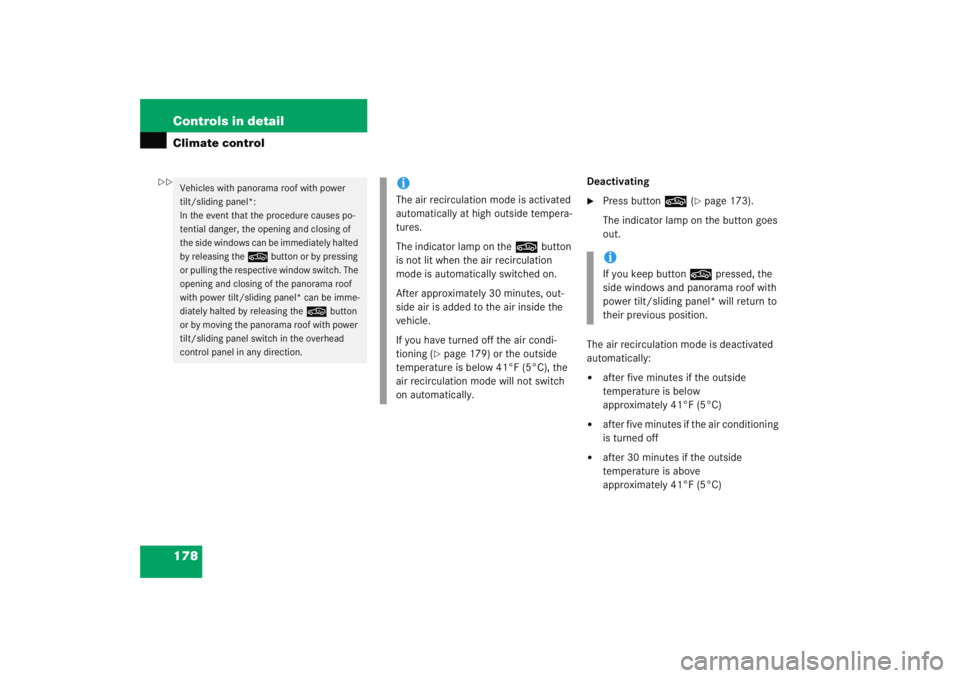
178 Controls in detailClimate control
Deactivating�
Press button, (
�page 173).
The indicator lamp on the button goes
out.
The air recirculation mode is deactivated
automatically:
�
after five minutes if the outside
temperature is below
approximately 41°F (5°C)
�
after five minutes if the air conditioning
is turned off
�
after 30 minutes if the outside
temperature is above
approximately 41°F (5°C)
Vehicles with panorama roof with power
tilt/sliding panel*:
In the event that the procedure causes po-
tential danger, the opening and closing of
the side windows can be immediately halted
by releasing the , button or by pressing
or pulling the respective window switch. The
opening and closing of the panorama roof
with power tilt/sliding panel* can be imme-
diately halted by releasing the , button
or by moving the panorama roof with power
tilt/sliding panel switch in the overhead
control panel in any direction.
iThe air recirculation mode is activated
automatically at high outside tempera-
tures.
The indicator lamp on the , button
is not lit when the air recirculation
mode is automatically switched on.
After approximately 30 minutes, out-
side air is added to the air inside the
vehicle.
If you have turned off the air condi-
tioning (
�page 179) or the outside
temperature is below 41°F (5°C), the
air recirculation mode will not switch
on automatically.
iIf you keep button , pressed, the
side windows and panorama roof with
power tilt/sliding panel* will return to
their previous position.
��
Page 180 of 474
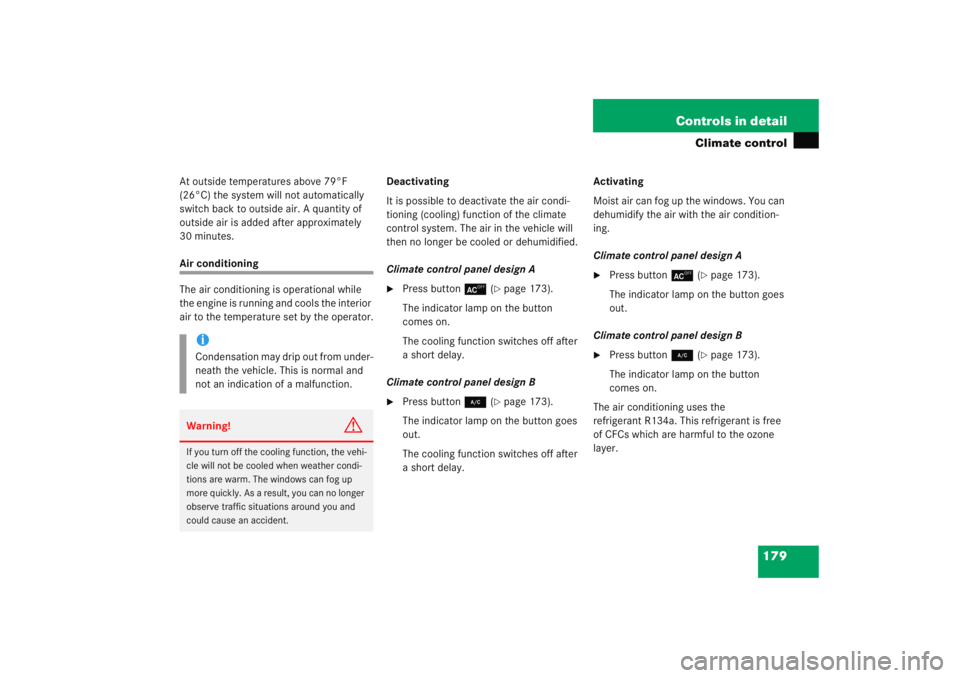
179
Controls in detail
Climate control
At outside temperatures above 79°F
(26°C) the system will not automatically
switch back to outside air. A quantity of
outside air is added after approximately
30 minutes.Air conditioning
The air conditioning is operational while
the engine is running and cools the interior
air to the temperature set by the operator.
Deactivating
It is possible to deactivate the air condi-
tioning (cooling) function of the climate
control system. The air in the vehicle will
then no longer be cooled or dehumidified.
Climate control panel design A
�
Press button
± (
�page 173).
The indicator lamp on the button
comes on.
The cooling function switches off after
a short delay.
Climate control panel design B
�
Press button 2 (
�page 173).
The indicator lamp on the button goes
out.
The cooling function switches off after
a short delay. Activating
Moist air can fog up the windows. You can
dehumidify the air with the air condition-
ing.
Climate control panel design A
�
Press button
± (
�page 173).
The indicator lamp on the button goes
out.
Climate control panel design B
�
Press button 2 (
�page 173).
The indicator lamp on the button
comes on.
The air conditioning uses the
refrigerant R134a. This refrigerant is free
of CFCs which are harmful to the ozone
layer.
iCondensation may drip out from under-
neath the vehicle. This is normal and
not an indication of a malfunction.Warning!
G
If you turn off the cooling function, the vehi-
cle will not be cooled when weather condi-
tions are warm. The windows can fog up
more quickly. As a result, you can no longer
observe traffic situations around you and
could cause an accident.
Page 181 of 474
180 Controls in detailClimate control
Rear passenger compartment adjustable air vents
The air conditioning for the rear passenger
compartment is controlled via the climate
control panel (
�page 173).The air vents for the rear passenger
compartment are located in the rear
center console.
1 Left center air vent
2 Thumbwheel for air volume control for
center air vents
3 Right center air vent
!If the air conditioning cannot be turned
on again, this indicates that the air
conditioning is losing refrigerant. The
compressor has turned itself off.
Have the air conditioning checked at
the nearest authorized Mercedes-Benz
Center.
iThe temperature at the center air vents
for the rear passenger
compartment 1 and 3 is the same as
at the dashboard center air vents.
Page 182 of 474
181
Controls in detail
Climate control
Adjusting air distribution�
Push the slide for the left center
vent
1 or right center vent 3 to the
left, right, up or down.
The air flow is directed in the corre-
sponding direction. Adjusting air volume
�
Turn thumbwheel
2 up or down.
The air volume is increased or
decreased.
iFor draft-free ventilation, push
slides 1 and 3 upward.
Page 183 of 474
182 Controls in detailAutomatic climate control*
Page 184 of 474
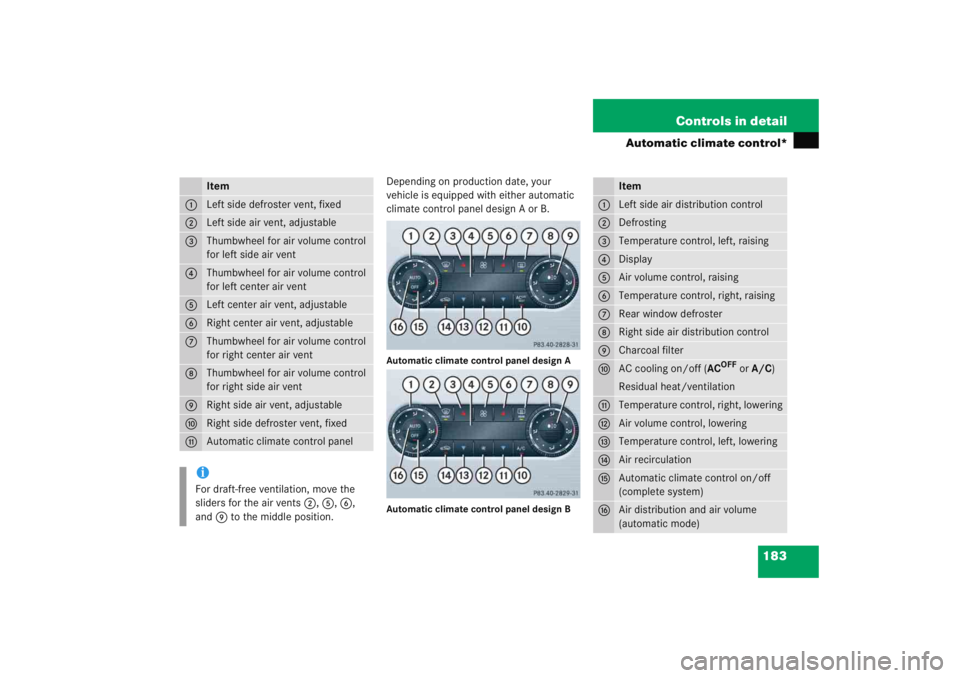
183
Controls in detail
Automatic climate control*
Depending on production date, your
vehicle is equipped with either automatic
climate control panel design A or B.Automatic climate control panel design A
Automatic climate control panel design B
Item
1
Left side defroster vent, fixed
2
Left side air vent, adjustable
3
Thumbwheel for air volume control
for left side air vent
4
Thumbwheel for air volume control
for left center air vent
5
Left center air
vent, adjustable
6
Right center air vent, adjustable
7
Thumbwheel for air volume control
for right center air vent
8
Thumbwheel for air volume control
for right side air vent
9
Right side air vent, adjustable
a
Right side defroster vent, fixed
b
Automatic climate control paneliFor draft-free ventilation, move the
sliders for the air vents 2,5 ,6 ,
and 9 to the middle position.
Item
1
Left side air distribution control
2
Defrosting
3
Temperature control, left, raising
4
Display
5
Air volume control, raising
6
Temperature control, right, raising
7
Rear window defroster
8
Right side air distribution control
9
Charcoal filter
a
AC cooling on/off ( AC
OFF
or A/C )
Residual heat/ventilation
b
Temperature control, right, lowering
c
Air volume control, lowering
d
Temperature control, left, lowering
e
Air recirculation
f
Automatic climate control on/off
(complete system)
g
Air distribution and air volume
(automatic mode)